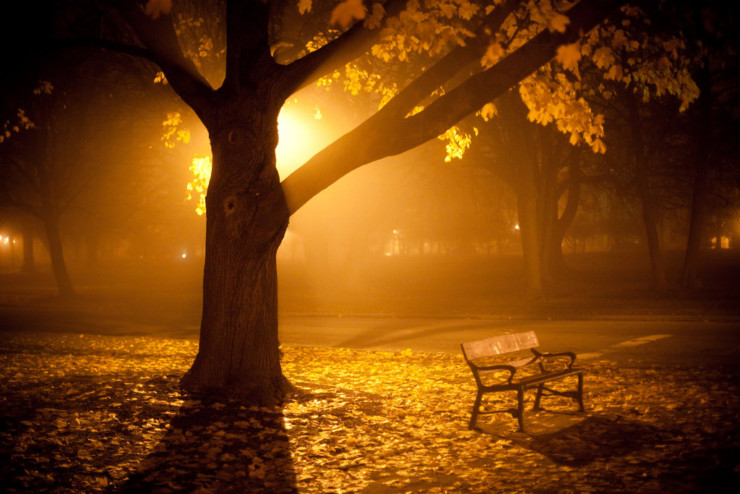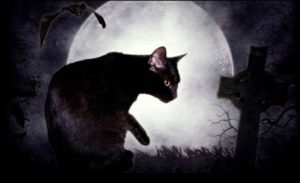
Think Halloween, and what comes to mind (after trick-or-treat candy) are the big three icons of witches, pumpkins, and black cats. Mummies, skeletons, and zombies are more Johnny-come-latelys in the Halloween extravaganza. These days, witches have gone mainstream respectable, and Linus and Charlie Brown own the Great Pumpkin, so the black cat is left to shoulder Halloween largely alone.
My family had a black cat. Actually, the cat had us. One day in the middle of winter the cat showed up in the neighborhood. It had a collar but no tags, and it looked healthy. The neighborhood children fed her potato chips and milk, guaranteeing she would hang around. My wife warned the children that, if they kept feeding it, the cat would never leave (not the best argument to make to a child).
And then, in early March, an unexpected cold snap pushed the temperature below zero. My wife, taking pity on the cat, let her stay in our garage. That’s all it took. In deep gratitude, the cat left my wife a thank-you present on the back step—a baby bunny with its head removed.
We were adopted, the deal sealed with a ritual sacrifice.

Edgar Allan Poe
The cat moved in. I’d never been a cat person, but I took the cat, whom our youngest gave the original name of “Kiddy,” to the local animal clinic for its shots. We learned there that the cat was a male. The name stayed the same.
Kiddy turned out to have the personality of a very friendly dog. He got along fine with our spaniel. He made himself at home on our laps while we watched television. He’d follow us on walks. All he asked was to be fed and allowed inside in the event of rain—he was terrified of thunderstorms.
Not all black cats have fared as well as Kiddy.
One of the creepiest stories written by Edgar Allan Poe (1809-1849) is “The Black Cat,” first published in 1843. The narrator, who starts life off as a rather charming man, gradually becomes a brute through alcoholism. He fearfully mistreats his black cat, and eventually hangs it from a tree outside the house. His terrible action results in a fit of remorse, and he resolves to find a cat to treat better. He does, but you know the evils of strong drink—back the man slides, and commits an even more fearsome act. In the end, the black cat has his revenge.
Rainer Maria Rilke (1875-1926) played to the common reaction to (and fear of) black cats with a poem, one so vivid that it could be a description of Poe’s black cat.
Black Cat

Rainer Maria Rilke
A ghost, though invisible, still is like a place
your sight can knock on, echoing; but here
within this thick black pelt, your strongest gaze
will be absorbed and utterly disappear:
just as a raving madman, when nothing else
can ease him, charges into his dark night
howling, pounds on the padded wall, and feels
the rage being taken in and pacified.
She seems to hide all looks that have ever fallen
into her, so that, like an audience,
she can look them over, menacing and sullen,
and curl to sleep with them. But all at once
as if awakened, she turns her face to yours;
and with a shock, you see yourself, tiny,
inside the golden amber of her eyeballs
suspended, like a prehistoric fly.
Our Kiddy never appeared menacing. He did like to surprise us, though. One of his favorite surprises was to leap upon a chest of drawers just inside the door of my son’s room and wait for one of us to walk into the room before he leaped. He also liked to sit calmly on the counter in the hall bathroom, waiting for someone to walk in and turn on the light to find THIS HUMONGOUS BLACK CAT just sitting there. Yes, it could be unnerving. The cat enjoyed it all. He also enjoyed chasing bunnies—he kept the rabbit population under control in the yard, and we often spotted him dining alfresco.

This Halloween, you might think of a black cat as Poe did—an instrument of rather blood-curdling revenge. You might consider Rilke’s cat, carrying your image in those amber eyes. You may just think about the traditional black cat, associated with bad luck.
Or you can think about Kiddy, the cat who should have been a dog, full of fun and surprises, leaping from the tops of dressers and leaving tokens of his gratitude at the back door.
Photo by Sebastien Barre, Creative Commons, via Flickr. Post by Glynn Young, author of the novels Dancing Priest and A Light Shining, and Poetry at Work.
__________________________

“I require all our incoming poetry students—in the MFA I direct—to buy and read this book.”
—Jeanetta Calhoun Mish
- Poets and Poems: Katie Kalisz and “Flu Season” - April 15, 2025
- Poets and Poems: Michelle Ortega and “When You Ask Me, Why Paris?” - April 10, 2025
- Robert Waldron Imagines the Creation of “The Hound of Heaven” - April 8, 2025
Kelly Chripczuk says
We also have a black cat, although he’s a tuxedo (white chest, paws and nose) so I don’t typically associate him with Halloween. He too acts more like a dog than a cat, which makes me wonder whether cats have gotten a bad and inaccurate rap over the years . . .
I always love a good cat story, Glynn and I’m happy to share this one in my monthly Newsletter. Thanks!
Glynn says
Thanks, Kelly! I think some cats have gotten a bad rap. Well, maybe most of them.
L.L. Barkat says
Glynn! 🙂
This post made me laugh a few times over, despite that I’m not generally one for dark humor. (Made doubly dark by a black cat? 😉 )
Maybe cats just always manage to be funny when in your writer’s hand. 🙂
Glynn says
I didn’t mention how Kiddy helped reduce my television watching. He had an unnerving tendency to jump in my lap while I watched TV, knead with claws extended until he found just the right position, and then curl up for a nap.
Bethany R. says
How funny that your “humungous black cat” would play these tricks on you. I read Poe’s story back in college, but I’ve never read the Rilke poem before. This grabbed me:
“she can look them over, menacing and sullen,
and curl to sleep with them.”
Glynn says
It’s a great line. And true.
Katie says
Okay, confession time – I’ve never owned a cat of any color. In fact, I wouldn’t say that I’m a cat person, but, I don’t dislike them either. I certainly have respect for how independent they are and how many of them can make a dog run for his life.
All that said – one more confession – I’m not a fan of Halloween either. Maybe it has something to do with the pink bunny suit I had to wear one year for trick-or-treat that was hot, scratchy, and wet by the time we got home with our candy.
Anywhoo – here are some cinquains I wanted to share after looking up “cat” in the good old Webster’s and finding catbird, cat-brier, catcall. Hope you enjoy and what the heck: Happy Halloween:)
slate-gray
caught in the thorns
desperately afraid
cat will get you before you can
escape
&
heart-shaped
leaves, small green flowers, black berries
thorny vine, does not shine
among my faves
be brave
&
catcall
harsh, shrill whistle
expressing derision
and/or extreme disapproval
boo you!
Gotta go – think our first “customers” are at the door!
Glynn says
Katie, these are wonderful! And from a non-cat person, too!
Katie says
Thank you, Glynn! It was fun writing them:) & thanks for sharing Kiddy with us:)
Monica Sharman says
Our first and only cat, we stole. Black and white, he or she (like you, we didn’t know until a vet visit) was under our car parked in front of the house. With a dish of milk, my brother and I lured the cat out from under the car, and into the house. My sister actually made scrambled eggs — with butter. I wished she had made me some too, but she gave it all to the cat. We named him B.J. (for Baby Jaguar, which works for male or female). Days or weeks later we were out on the lawn with B.J., and a little girl walked by, pointing and saying, “Daddy! It’s Tripper!” My brother, who knew what was going on, quietly slithered back into the house. I, clueless, said, “That’s not Tripper! That’s B.J.!” The dad talked with our mom, and we gave back the cat. But B.J. kept coming back to our house, so they gave up and gave us the cat as well as the rest of their big bag of kitty litter.
Glynn says
Monica, I always thought that the way to a dog’s heart was through its stomach. Now it must be true for cats as well.
Sandra Heska King says
We are definitely cat people and have had several, all strictly indoor, over the years. None of them worth their keep except for their different personalities. There was Sneakers, a black and white tuxedo boy. And really, he kind of just snuck around. He really was a scaredy cat.
But then there was our B.J.–short for Bagheera, Jr. (The daughter named him cuz her friend had a Bagheera.) He was a kitten when we found him–can’t remember where. He had a hole in his neck, and we thought he’d been bitten or something. Turns out some kind of grub had burrowed in there, and it was a real ewwwww moment when the vet pulled it out. That cat, though, was of the devil. Possessed, I think. It’d rip into you for no reason. We didn’t have him long before we had to put him down for our own protection.
Glynn says
If I had had a worm in my neck, I would have been possessed as well.
Katie says
Furry
Egocentric
Lioness
Inexorable
Extremely high maintenance
Katie says
Just came across my FELINE acrostic and found it’s missing the “N” line:
So here is “FELINE” with an addition and one edit:
Furry
Egocentric
Lioness
Inexorable
Naughty or Nice
Extremely LOW maintenance
🙂
Bethany R. says
Fun to read each of your cat stories here. 🙂